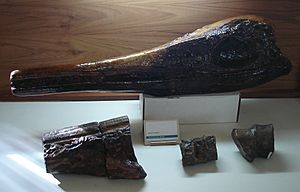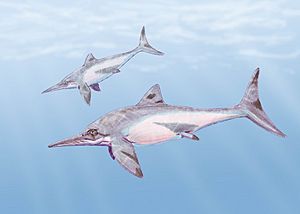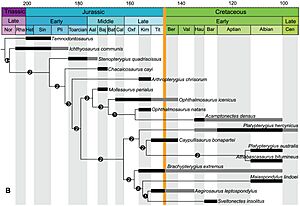Platypterygius facts for kids
Quick facts for kids Platypterygius |
|
|---|---|
 |
|
| Skull of P. sachicarum in the Paleontological Museum in Villa de Leyva, Colombia | |
| Scientific classification | |
| Kingdom: | |
| Phylum: | |
| Class: | |
| Order: | |
| Family: | |
| Subfamily: |
†Platypterygiinae
|
| Genus: |
†Platypterygius
von Huene 1922
|
| Species | |
|
|
Platypterygius (say: Plat-ip-TER-ih-jee-us) was a type of ancient marine reptile called an ichthyosaur. Its name means 'flat flipper'. It was one of the very last ichthyosaurs to live on Earth.
Contents
Discovering Platypterygius
Scientists have found fossils of Platypterygius in many places. These include Australia, Russia, the United States, Colombia, and parts of Western Europe. It's even possible some were found in New Zealand.
There are seven different types, or species, of Platypterygius that scientists have named. Fossils of both adult and young Platypterygius have been found. This includes baby ichthyosaurs and even pregnant females. Just like some modern marine animals, Platypterygius gave birth to live young.
What Platypterygius Looked Like
Platypterygius was a large marine reptile. It could grow to be about 7 meters (23 feet) long. That's longer than a typical car!
It had a long snout, which was probably good for catching fish. It also had a strong tail with fins, which helped it swim fast. Its front flippers were special. They had more "fingers" than most other ichthyosaurs. These "fingers" were packed together, making the flippers wide and flat. This unique feature is how Platypterygius got its name, meaning 'flat wing' or 'flat flipper'. Some of its wrist bones were even missing!
Scientists used special scans, like CAT scans, on a young Platypterygius fossil. These scans suggest that Platypterygius might have been deaf.
Why Platypterygius Disappeared
Platypterygius became extinct during a time called the Upper Cretaceous period. This was about 30 million years before the famous event that wiped out the dinosaurs.
During that time, there was a big change in the oceans. It's called an ocean anoxic event. This means that the deeper parts of the sea lost most of their oxygen. They also became filled with a poisonous gas called hydrogen sulphide.
When the oxygen disappeared, many small creatures at the bottom of the food chain died. This had a huge effect on the animals that ate them. Eventually, the larger predators, like the last pliosaurs and ichthyosaurs (including Platypterygius), also died out.
Scientists aren't completely sure why ichthyosaurs declined. By the Cretaceous period, they had more animals competing for food. Their prey (the animals they hunted) also became faster and harder to catch. New types of fast-swimming fish appeared, which were both competitors and harder to hunt. The ocean anoxic event, which removed much of the tiny plankton at the base of the food chain, certainly played a big role in the extinction of many large ocean predators.
Images for kids
-
An opalized backbone from a young Platypterygius.
See also
 In Spanish: Platypterygius para niños
In Spanish: Platypterygius para niños




